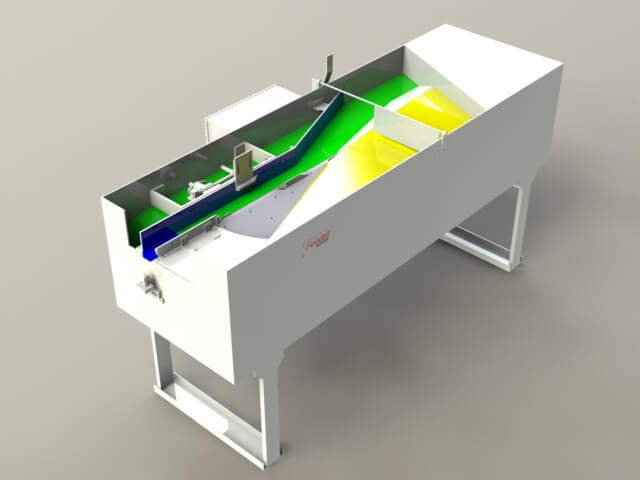About Bidirectional Conveyors and What They’re Used For
A bidirectional conveyor is a critical piece of machinery in any manufacturing or production environment — and for great reason. The bidirectional aspect of this conveyor type refers to the fact that there are two belts running in opposite directions. This allows for a part to recirculate through a production system until it is finally able to exit or be presented to another unit in the secondary process such as a heater, press or robot pick off.
One of the key differentiating factors of a bidirectional conveyor is that it can be engineered and built to allow for complete part manipulation and orientation. Take steel tubes for example: they are a few to several inches long with diameters of one inch or more. Because they have such a cylindrical shape, a bidirectional conveyor would recirculate these parts until they finally achieved the desired position that made subsequent loading or escapement possible. If the tube doesn’t achieve the necessary position on the first pass, it gets recirculated repeatedly until it does.
But this is just one of the many flexible benefits of a bidirectional conveyor. In fact, bidirectional conveyors allow companies with complex production requirements to take advantage of numerous other system features — many of which can be customized to meet their specific production demands. Let’s take a look at some of the other ways bidirectional conveyors improve production for multiple industries.
How Bidirectional Conveyors Enhance Production Environments
1. They Enable Part Flexibility
Most companies are producing or working with numerous components as part of their overall production chain. This could include anything from the steel tubes mentioned earlier to more disc-shaped components, bearings, and countless other parts. Each is important to the production process, but how can they efficiently move these parts from one unit to another? Are separate conveyors needed to accommodate different parts?
Not at all! Bidirectional conveyors can be designed and tooled to accommodate an extremely wide range of parts in a single machine. This is particularly beneficial in that it reduces the number of machines required and thus the amount of capital companies need to feed multiple parts in their production, nor is there any need to swap out machines, create more complex chains, or implement some manual procedure for swapping parts.
2. They Keep Production Moving Swiftly
For manufacturers and other production-oriented companies, speed matters. The ability to produce products and keep processes moving efficiently makes a direct and immediate impact on margins and companies’ overall bottom lines. With a bidirectional conveyor, companies can take advantage of rapid feeding speeds — often up to 60 parts per minute in some applications.
It’s worth comparing this to robotic speeds, which max out at around four parts per minute — much slower than a bidirectional conveyor system. While modern robotics may appear to move swiftly and precisely in a production environment, there are still seconds that pass as arms move from a conveyor where parts are retrieved to a destination where the part is released. Coupled with the fact that robotics themselves are costly and require additional software, programming, and maintenance, it doesn’t make sense to utilize robotics when a bidirectional conveyor can move parts 15 times faster.
3. They Make Loading and Escapement a Breeze
Remember, a bidirectional conveyor is precisely that — a conveyor. It’s meant to help parts and components along in the production process. There is still a step before (loading) and a step after (escapement) that must be considered. Strategically, a bidirectional conveyor adds considerable value because it allows for a number of loading and escapement options, which makes the conveyor incredibly flexible and useful long-term.
On the loading end, you might have anything from a series of robotics pulling from another production step to employees dumping parts manually with totes. Or a hopper feeder might be dropping batches of parts as it collects them from a previous process. When it comes to escapement, bidirectional conveyors can accommodate a range of secondary operations such as robotic pick-off, induction heaters, presses, accumulation tables, automation cells, and much more.
4. They’re Non-Marring and Non-Intrusive
Quality is important — not just in terms of the end product but also in terms of its parts. That’s why bidirectional conveyors are non-marring, as in they don’t cause any damage, wear, or other negative impact on parts as they move along its belts. This ensures that both the part and the final product are produced to high-quality standards.
Additionally, bidirectional conveyors are low-noise. Production environments can be extremely loud depending on what is being produced, and many workers are required to wear personal protective equipment (PPE) to address this, ranging from eyewear to hearing protection. While other machines may require these protective measures for facility workers, bidirectional conveyors will certainly not be a contributor.
Is It Time to Improve Your Production Environment?
Conveyor systems are critical for moving parts throughout a production environment. Bidirectional conveyors take this important function and add a significant amount of flexibility, making companies’ processes more efficient and customized to their unique needs. If your organization has been looking to streamline its production chain, improve the quality of your product or parts, and benefit from equipment that works relentlessly for your business for years with minimal service needs, we’d love to hear from you.
